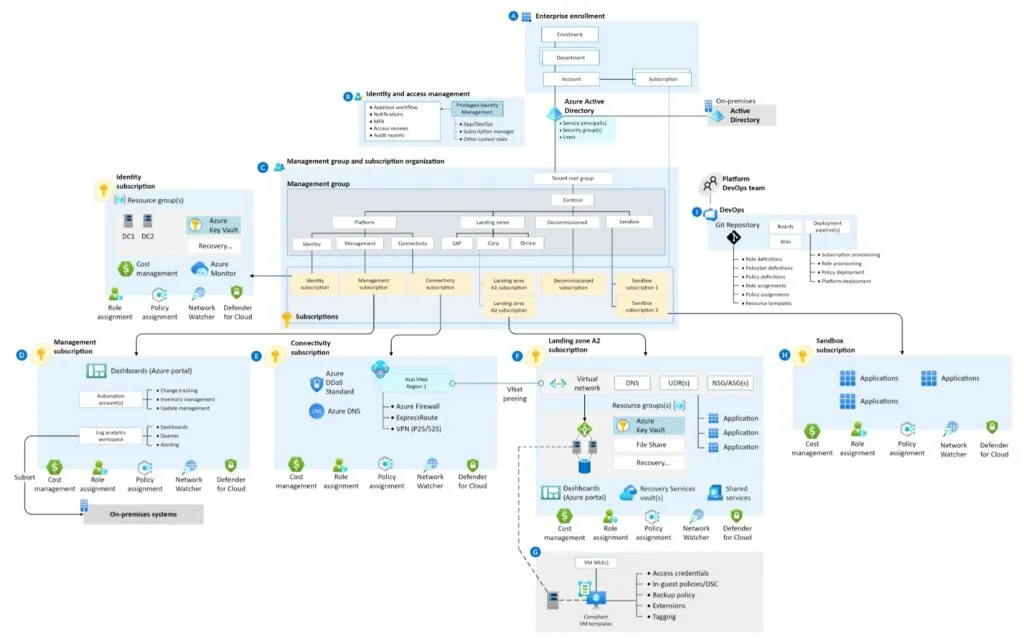Cloud landing zones serve as fundamental frameworks that streamline the deployment and administration of workloads within a company’s cloud ecosystem. Platform Landing Zones (PLZ) and Application Landing Zones (ALZ) stand out as two significant types of landing zones. Despite both being integral to cloud infrastructure, they serve distinct functions and possess unique characteristics.
This blog post aims to discuss the difference between Platform and Application Landing Zones to provide a comprehensive understanding of each.

Platform Landing Zones (PLZ):
Platform Landing Zones, as their name implies, lay the groundwork for an organization’s entire cloud infrastructure. They are crafted to establish a standardized, scalable, and secure foundation that accommodates various workloads and applications. Key attributes of PLZ include:
- Foundational Infrastructure: PLZ encapsulates core infrastructure components such as networking, identity and access management (IAM), security, logging, and monitoring. These components are provisioned and configured following best practices and organizational policies.
- Centralized Governance: PLZ integrates centralized governance mechanisms to enforce compliance, security, and operational policies throughout the cloud environment. This ensures uniformity and adherence to regulatory requirements and industry standards.
- Scalability and Flexibility: PLZ architecture is designed to accommodate growth and scale seamlessly. It offers the flexibility to onboard new services and adapt to evolving business requirements without compromising stability or security.
- Cost Optimization: PLZ prioritizes cost optimization strategies by implementing resource tagging, usage tracking, and budgeting mechanisms. This facilitates efficient resource allocation and cost management across the organization’s cloud footprint.
An example of PLZ will include a Landing zone that is CMMC compliant or an Azure Mission Landing Zone, which is a highly opinionated Infrastructure-as-Code (IaC) template that IT oversight organizations can use to create a cloud management system to deploy Azure environments for their workloads and teams. Microsoft provides accelerators for PLZ with Terraform and Bicep as deployment options which can be used as a starting point and customised as per requirements.
Application Landing Zones (ALZ):
In contrast to PLZ, Application Landing Zones are bespoke environments optimized for specific applications or workloads. Application LZ are environments deployed for the workloads themselves. They are built on the foundation provided by PLZ but are tailored to meet the unique requirements of individual applications. Key characteristics of Application LZ include.
- Application-Centric Design: ALZ revolves around catering to the specific needs and traits of the hosted application. This may entail specialized networking configurations, storage options, compute resources, and service integrations tailored to enhance performance and functionality.
- Isolation and Segmentation: ALZ frequently incorporates isolation and segmentation mechanisms to allocate dedicated resources and boundaries for each application. This bolsters security, resilience, and performance by minimizing interference and resource contention among different applications.
- Automated Deployment and Orchestration: ALZ leverages automation and orchestration tools to streamline the deployment, configuration, and management of application resources. This enables swift provisioning, scaling, and updates, reducing manual overhead and bolstering agility.
- Monitoring and Performance Optimization: ALZ encompasses monitoring and performance optimization capabilities specific to the hosted application. This entails customized metrics, alerts, and tuning parameters tailored to monitor application health, identify bottlenecks, and optimize performance.
Examples of Application Landing Zones in Azure are the AKS Landing Zone, the Azure Virtual Desktop Landing Zone, the SAP Landing Zone, and the Azure Spring Apps Landing Zone.
In essence, Platform Landing Zones and Application Landing Zones are indispensable components of cloud architecture, each fulfilling distinct roles within an organization’s cloud environment. While Platform LZ furnishes a standardized foundation for the entire infrastructure, Application Landing Zones provide tailored environments optimized for specific applications or workloads. Understanding the disparities between these two landing zones is imperative for devising and implementing effective cloud architectures that cater to the diverse needs of modern enterprises






